Building Ritchie/DeBellevue's Double MiG Killer F-4E
A conversion of Revell's F-4F into an early F-4E in 1:32 scale
By Menelaos Skourtopoulos
& Col. Charles 'Chuck' DeBellevue (USAF, Ret)
|
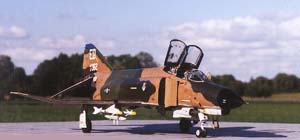 |
Introduction
The F-4E Phantom II is a legend among modern combat aircraft. There
are many stories written about the Phantom in action. The Phantom has
served in the Air Forces of many countries. The systems on it have been
modified to keep it competitive with more modern fighters and the F-4
is still employed in a number of countries. For the United States, the
Phantom played a principal role in the Vietnam War and is now being used
as a full scale aerial target.
This article is a tribute to the pilots and WSOs that flew the Phantom
over the North Vietnam.
History (narrative by C. DeBellevue)
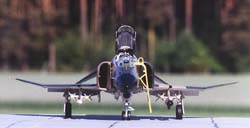 It
was the 8th of July 1972 and four F-4Es of the 555th Tactical Fighter
Squadron (TFS), 432nd Tactical Reconnaissance Wing (TRW) took off from
Udorn RTAFB (Royal Thai Air Force Base) and headed north for another Combat
Air Patrol (CAP) mission. It
was the 8th of July 1972 and four F-4Es of the 555th Tactical Fighter
Squadron (TFS), 432nd Tactical Reconnaissance Wing (TRW) took off from
Udorn RTAFB (Royal Thai Air Force Base) and headed north for another Combat
Air Patrol (CAP) mission.
The flight's call sign was 'Paula'. 'Paula 01' was an F-4E (67-362)
TDY from the 33rd TFW, 58th TFS from Eglin AFB. Capt. Steve Ritchie, the
pilot of 'Paula 01', was crewed with Capt. Chuck DeBellevue, WSO. Capt.
Ritchie had already shot down two MiG21s, the first flying with Capt.
DeBellevue and the second with Capt. Larry Pettit. This Phantom was an
'E' model, which meant it carried a 20mm six barrel gun in the nose, in
addition to four Sparrows, four Sidewinders, two ECM podes under the Sidewinder
pylons and could carry three external fuel tanks.
'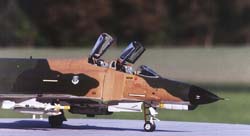 We
were flying over 'Banana Valley' a valley 30 miles southwest of Hanoi
when a warning call came from the airborne radar controller on 'Disco':
'They are two miles north of you, Paula!' Disco was the call sign of the
EC-121 that provided radar surveillance and enemy intercept information
on enemy fighters during the strikes into North Vietnam. We
were flying over 'Banana Valley' a valley 30 miles southwest of Hanoi
when a warning call came from the airborne radar controller on 'Disco':
'They are two miles north of you, Paula!' Disco was the call sign of the
EC-121 that provided radar surveillance and enemy intercept information
on enemy fighters during the strikes into North Vietnam.
In scanning the skies, I felt that the MiGs were in front of us. I
spotted a black fly speck on a white cloud at eleven o'clock, just to
the left of the nose, and called it out to Ritchie. Ritchie turned slightly
left and went to full afterburner and jettisoned his external wing tanks.
A few seconds later, a shiny MiG-21 passed close to the F-4 and turned
away in level turn. From flying in North Vietnam on a daily basis, we
knew that the MiGs did not normally fly combat missions as single ships.
We also knew that a favourite tactic was for the lead aircraft to be the
bait, hoping to get the F-4s to follow. Then the second MiG would have
an easy shot at the F-4s that were belly up to the real threat. However,
as we waited for the second MiG-21 to come by, Ritchie rolled 362 over
135 degrees and set the wings for a slicing maneuver. The second MiG-21
also turned away in a level turn and followed the first MiG.
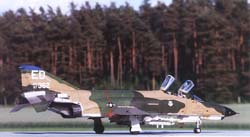 Ritchie
sliced hard left into the MiGs and ended up at the trailing MiGs 5 o'clock
at 6.000 ft. I had set up the radar in an automatic acquisition mode so
that Ritchie could lock on to the MiG-21 from the front seat. Ritchie
fired two AIM-7 Sparrows (the Sparrow had a bad reputation of not being
a very reliable missile). Ritchie
sliced hard left into the MiGs and ended up at the trailing MiGs 5 o'clock
at 6.000 ft. I had set up the radar in an automatic acquisition mode so
that Ritchie could lock on to the MiG-21 from the front seat. Ritchie
fired two AIM-7 Sparrows (the Sparrow had a bad reputation of not being
a very reliable missile).
In the meantime, the MiG pilot spotted the F-4 threatening him and
started a hard turn. The turning capability of the '21' was tremendous
and as the Sparrows came off of the Phantom the MiG was 45 degrees off
the nose of the F-4. Both missiles guided perfectly. The first made a
60-degree turn and hit the MiG right behind the canopy, blowing it in
half. The second made a 90-degree turn and flew right through the fireball!
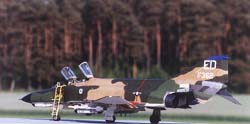 Meanwhile
'Paula 04' was being threatened by the other MiG and called for help.
Ritchie had unloaded to get his airspeed up, knowing that the second MiG
would probably depart the fight. When 'Paula 04' called to say that the
other MiG was behind him, Ritchie came back into the fight. He fired one
Sparrow but the MiG was now 60 degrees off his nose. The missile was an
aft AIM-7. When the AIM-7 is fired, it does a roll maneuver under the
F-4, the wings are set based on the information provided by the radar
and the missile motor fires. The first time we saw this missile it was
already turning to try to intercept the MiG. Ritchie didn't think that
the missile would guide, but it did. It made a 90-degree turn like a Sidewider
would and hit the MiG behind the canopy. The result was tremendous. The
MiG was pulling at least 6 Gs into the missile and literally disintegrated. Meanwhile
'Paula 04' was being threatened by the other MiG and called for help.
Ritchie had unloaded to get his airspeed up, knowing that the second MiG
would probably depart the fight. When 'Paula 04' called to say that the
other MiG was behind him, Ritchie came back into the fight. He fired one
Sparrow but the MiG was now 60 degrees off his nose. The missile was an
aft AIM-7. When the AIM-7 is fired, it does a roll maneuver under the
F-4, the wings are set based on the information provided by the radar
and the missile motor fires. The first time we saw this missile it was
already turning to try to intercept the MiG. Ritchie didn't think that
the missile would guide, but it did. It made a 90-degree turn like a Sidewider
would and hit the MiG behind the canopy. The result was tremendous. The
MiG was pulling at least 6 Gs into the missile and literally disintegrated.
 Ritchie
called 'Splash Two!' and after making sure no other MiGs were threatening
the flight, flew back to Udorn. A call was made to the command post so
that the wing would know of the kills and could let the maintenance crews
know that there was going to be an air show in a few minutes. After the
air show, which was equally as good as any performance put on by the USAF
Thunderbirds, there was a big celebration that night!' Ritchie
called 'Splash Two!' and after making sure no other MiGs were threatening
the flight, flew back to Udorn. A call was made to the command post so
that the wing would know of the kills and could let the maintenance crews
know that there was going to be an air show in a few minutes. After the
air show, which was equally as good as any performance put on by the USAF
Thunderbirds, there was a big celebration that night!'
That was Ritchie's 3rd and 4th kills and DeBellevue's 2nd and 3rd.
Ritchie and DeBellevue were crewed together when Ritchie made ace status
flying the well known F-4D 67-463 on 28 Aug. 1972. DeBellevue ended the
war as the highest scoring ace with six kills to his credit when he scored
his 5th and 6th kills on 09 Sept. 1972 in F-4D 60-267, while crewed with
Capt John Madden.
Building 'F-4E 362'
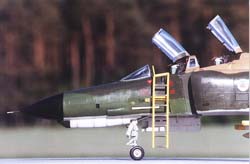 The
story began last year as I wanted to build an early F-4E out of Revell's
F-4F kit in 1:32nd scale. There is, of course, a Tamiya F-4E available,
but I already had the Revell kit and wanted to make a conversion. The
story began last year as I wanted to build an early F-4E out of Revell's
F-4F kit in 1:32nd scale. There is, of course, a Tamiya F-4E available,
but I already had the Revell kit and wanted to make a conversion.
There were two options for this project: An early USAF F-4E or an early
Israeli F-4E. I chose the first because I had all of the decals I needed
for it and the story of the double MiG Kill was most interesting.
I searched for pictures of that aircraft but couldn't find anything.
The only source I had was Lou Drendels books '..and Kill MiGs' and 'USAF
Phantoms in Combat'. In the second book there's a great paint job of the
'362'. I went so far that I contacted Steve Ritchie himself, but he couldn't
help me either. So I was very happy and proud to made contact with Col.
DeBellevue, who gave me a lot of the information I needed for the project.
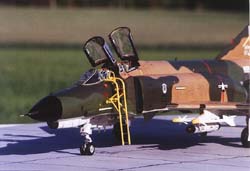 Here
are some more details about the F-4s at the time: Here
are some more details about the F-4s at the time:
Ritchie and DeBellevue were crewed together and flew on all the CAP missions.
'362' had just come out of radar calibration and had to go back into radar
calibration because after the second kill, the radar burned itself up
and quit working. It had lasted just long enough to get the job done.
During that time frame (Linebacker) the F-4E was going through many
modifications. One of these was the Midas Gun Mod, where the longer gun
fairing was installed, replacing the short one. Another mod was the "Strip
Lights" or Formation Lights. Some aircraft had one or more of the mods
completed and some had none. When the F-4E deployed to Udorn for Linebacker
the teeth were painted on the nose as shown in many photographs but not
on '362'. They were removed from all aircraft after the return to the
states. The TAC badge was removed after the arrival, but the Squadron
and Wing patch remained. Unit involved was the 33 TFW, (Nomads) 58TFS
(Mo-Gilla Go-Rilla). They were assigned to the 432 TRW for support. The
fin cap was painted blue with white ED on the tail.
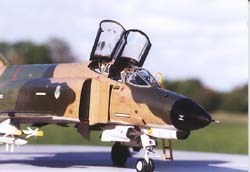 Of
interest, at that time the normal loadout for the lead aircraft on a MIG
CAP or long range BUFF escort mission, was four AIM-7Es, four AIM-9Js,
two 370 Gal drop tanks, one 600 Gal centerline tank, one ALQ-87 ECM pod
on the left inboard pylon, and one ALQ-101 ECM pod on the right inboard
pylon. The wingmen would have four AIM-9Es, as the Js were new and in
short supply. On MIG sweeps and short range escort only one ECM pod was
carried, but the wingman would have the other pod loaded on his aircraft.
Also the 600 Gal centerline tank would not be carried. Of
interest, at that time the normal loadout for the lead aircraft on a MIG
CAP or long range BUFF escort mission, was four AIM-7Es, four AIM-9Js,
two 370 Gal drop tanks, one 600 Gal centerline tank, one ALQ-87 ECM pod
on the left inboard pylon, and one ALQ-101 ECM pod on the right inboard
pylon. The wingmen would have four AIM-9Es, as the Js were new and in
short supply. On MIG sweeps and short range escort only one ECM pod was
carried, but the wingman would have the other pod loaded on his aircraft.
Also the 600 Gal centerline tank would not be carried.
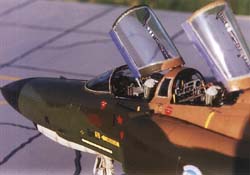 The
ECM pods were carried on the forward AIM-7 stations only on ground attack
missions. The 58th flew only MIG Cap, MIG sweep, Trap and Bait, long and
short range escort, and Res Cap missions. The ECM pods were installed
on the inboard pylons. There would be two installed, one ALQ-87 and one
ALQ-101. If only one was carried, the wingman usually carried the other
type. This way they could provide noise and deception coverage. On MIG
Cap and long range escort the load out would be one 600 gal centreline
tank, two 370 gal tanks, four AIM-7E's four AIM-9J and two ECM pods. On
MIG sweep, Trap and Bait, short range escort, the load out would be the
same, except the 600 Gal tank would not be carried. Res Cap missions,
same except only one ECM pod. The
ECM pods were carried on the forward AIM-7 stations only on ground attack
missions. The 58th flew only MIG Cap, MIG sweep, Trap and Bait, long and
short range escort, and Res Cap missions. The ECM pods were installed
on the inboard pylons. There would be two installed, one ALQ-87 and one
ALQ-101. If only one was carried, the wingman usually carried the other
type. This way they could provide noise and deception coverage. On MIG
Cap and long range escort the load out would be one 600 gal centreline
tank, two 370 gal tanks, four AIM-7E's four AIM-9J and two ECM pods. On
MIG sweep, Trap and Bait, short range escort, the load out would be the
same, except the 600 Gal tank would not be carried. Res Cap missions,
same except only one ECM pod.
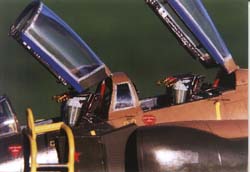 When
flying BUFF escort, they carried four each of the missiles, three bags
of gas, and only one ECM pod. The 600 Gal tank was jettisoned as soon
as it became empty. With a full load like that, it was hard to keep up
with the BUFF's, especially at the altitudes the BUFF flew. When
flying BUFF escort, they carried four each of the missiles, three bags
of gas, and only one ECM pod. The 600 Gal tank was jettisoned as soon
as it became empty. With a full load like that, it was hard to keep up
with the BUFF's, especially at the altitudes the BUFF flew.
Alert aircraft carried the eight missile loadout, two 370s and one
ECM pod.
The MiG kill markings:
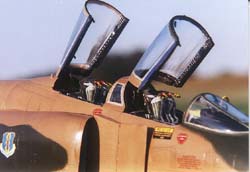 The
original stars were flat red with no outline. Prior to returning back
to the States, all MiG killers were repainted with gloss red stars, with
gloss yellow outlines. The type of aircraft destroyed was printed in the
stars, in gloss white with the date below the stars in gloss white. If
you want to show the aircraft as it appeared while still flying combat
missions the stars will be flat red with no outline. The
original stars were flat red with no outline. Prior to returning back
to the States, all MiG killers were repainted with gloss red stars, with
gloss yellow outlines. The type of aircraft destroyed was printed in the
stars, in gloss white with the date below the stars in gloss white. If
you want to show the aircraft as it appeared while still flying combat
missions the stars will be flat red with no outline.
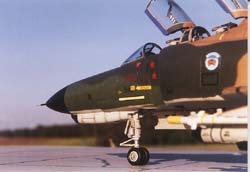 So
I had to find some extra parts to make an early F-4E. First I found the
outer unslated wings from the Revell RF-4C kit. I got the slated stabilators,
the short gun muzzle and the front gear leg via Paul Stoner (thanks Paul!).
The muzzle is from the Tamiya kit and I had to use some putty to fix it. So
I had to find some extra parts to make an early F-4E. First I found the
outer unslated wings from the Revell RF-4C kit. I got the slated stabilators,
the short gun muzzle and the front gear leg via Paul Stoner (thanks Paul!).
The muzzle is from the Tamiya kit and I had to use some putty to fix it.
The Revell kit, as I mentioned many times, presented some problems,
but they are all solvable. The most work that had to be done was to reshape
the radome.
The ejection seats are from CAM with the Eduard harnesses on them.
For the cockpit I used the front panel of the Monogram F-4E kit and the
WSO panel of the Tamiya kit.
Second problem was the ECM pods. I had the ALQ-87 from my Tamiya F-4C/D
kit. The ALQ-101 had to be made from scratch. I used an old Maverick missile
that I cut the fins off and used some putty to give it the appropriate
shape.
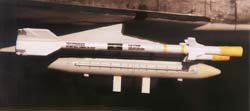 The
AIM-9s are all from Revells F-5E kit (not the Hasegawa reissue but the
older Revell kit). Their protective caps are made from paper! I build
the 362 as it was after landing, so I didn't use any external tanks and
only an aft AIM-7. The
AIM-9s are all from Revells F-5E kit (not the Hasegawa reissue but the
older Revell kit). Their protective caps are made from paper! I build
the 362 as it was after landing, so I didn't use any external tanks and
only an aft AIM-7.
Painting
I painted the Model in the typical SEA pattern camo. I used enamels
from Humbrol for that job. Again everything was made by brush, no paintguns.
Decals
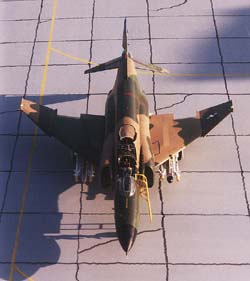 Many
of the decals are self-made. I had to search and found the badges of the
33rd and 58th units in the world wide web. I printed them on clear decal. Many
of the decals are self-made. I had to search and found the badges of the
33rd and 58th units in the world wide web. I printed them on clear decal.
The big number '362' was made from Tamiya''s decals for the F-4E from
the number '392' (again thanks to Paul Stoner). The AF and 67 made from
decals found in the spare box.
The big 'ED' made again from white decal.
Conclusion
I'm very glad to have this model. The short gun F-4E is again something
different beside the other F-4Es! I hope that I made the '362' as accurate
as it really was. Col. DeBellevue said to me: 'it looks like the real
thing!!'
I would like to thank Col. DeBellevue for his support and contribution
for this article. It's a great honour for me having him as a co-author
for this article.
I would like to send a BIG 'thanks' to Mr. Paul Stoner for sending
me the Tamiya Parts and decals I used, and Mrs. Tina Pohl for her great
assistance by taking those pictures!
Chuck DeBellevue commented that the pictures of the model looked like
the real thing and he wanted to know where I had gotten the pictures,
since he did not have any of '362'!!.
References
-
..and Kill MiGs. Air to Air combat in the Vietnam War (Lou Drendel)
USAF Phantoms in Combat (Lou Drendel)
-
Air War Over Southeast Asia. A pictorial Record Vol. 3 1971-1975
(Lou Drendel)
-
F-4 Phantom II in Action (Larry Davis)
-
F-4 in Detail and scale Vol. 2 (Bert Kinzey)
|
|

 It
was the 8th of July 1972 and four F-4Es of the 555th Tactical Fighter
Squadron (TFS), 432nd Tactical Reconnaissance Wing (TRW) took off from
Udorn RTAFB (Royal Thai Air Force Base) and headed north for another Combat
Air Patrol (CAP) mission.
It
was the 8th of July 1972 and four F-4Es of the 555th Tactical Fighter
Squadron (TFS), 432nd Tactical Reconnaissance Wing (TRW) took off from
Udorn RTAFB (Royal Thai Air Force Base) and headed north for another Combat
Air Patrol (CAP) mission. We
were flying over 'Banana Valley' a valley 30 miles southwest of Hanoi
when a warning call came from the airborne radar controller on 'Disco':
'They are two miles north of you, Paula!' Disco was the call sign of the
EC-121 that provided radar surveillance and enemy intercept information
on enemy fighters during the strikes into North Vietnam.
We
were flying over 'Banana Valley' a valley 30 miles southwest of Hanoi
when a warning call came from the airborne radar controller on 'Disco':
'They are two miles north of you, Paula!' Disco was the call sign of the
EC-121 that provided radar surveillance and enemy intercept information
on enemy fighters during the strikes into North Vietnam. Ritchie
sliced hard left into the MiGs and ended up at the trailing MiGs 5 o'clock
at 6.000 ft. I had set up the radar in an automatic acquisition mode so
that Ritchie could lock on to the MiG-21 from the front seat. Ritchie
fired two AIM-7 Sparrows (the Sparrow had a bad reputation of not being
a very reliable missile).
Ritchie
sliced hard left into the MiGs and ended up at the trailing MiGs 5 o'clock
at 6.000 ft. I had set up the radar in an automatic acquisition mode so
that Ritchie could lock on to the MiG-21 from the front seat. Ritchie
fired two AIM-7 Sparrows (the Sparrow had a bad reputation of not being
a very reliable missile). Meanwhile
'Paula 04' was being threatened by the other MiG and called for help.
Ritchie had unloaded to get his airspeed up, knowing that the second MiG
would probably depart the fight. When 'Paula 04' called to say that the
other MiG was behind him, Ritchie came back into the fight. He fired one
Sparrow but the MiG was now 60 degrees off his nose. The missile was an
aft AIM-7. When the AIM-7 is fired, it does a roll maneuver under the
F-4, the wings are set based on the information provided by the radar
and the missile motor fires. The first time we saw this missile it was
already turning to try to intercept the MiG. Ritchie didn't think that
the missile would guide, but it did. It made a 90-degree turn like a Sidewider
would and hit the MiG behind the canopy. The result was tremendous. The
MiG was pulling at least 6 Gs into the missile and literally disintegrated.
Meanwhile
'Paula 04' was being threatened by the other MiG and called for help.
Ritchie had unloaded to get his airspeed up, knowing that the second MiG
would probably depart the fight. When 'Paula 04' called to say that the
other MiG was behind him, Ritchie came back into the fight. He fired one
Sparrow but the MiG was now 60 degrees off his nose. The missile was an
aft AIM-7. When the AIM-7 is fired, it does a roll maneuver under the
F-4, the wings are set based on the information provided by the radar
and the missile motor fires. The first time we saw this missile it was
already turning to try to intercept the MiG. Ritchie didn't think that
the missile would guide, but it did. It made a 90-degree turn like a Sidewider
would and hit the MiG behind the canopy. The result was tremendous. The
MiG was pulling at least 6 Gs into the missile and literally disintegrated. Ritchie
called 'Splash Two!' and after making sure no other MiGs were threatening
the flight, flew back to Udorn. A call was made to the command post so
that the wing would know of the kills and could let the maintenance crews
know that there was going to be an air show in a few minutes. After the
air show, which was equally as good as any performance put on by the USAF
Thunderbirds, there was a big celebration that night!'
Ritchie
called 'Splash Two!' and after making sure no other MiGs were threatening
the flight, flew back to Udorn. A call was made to the command post so
that the wing would know of the kills and could let the maintenance crews
know that there was going to be an air show in a few minutes. After the
air show, which was equally as good as any performance put on by the USAF
Thunderbirds, there was a big celebration that night!' The
story began last year as I wanted to build an early F-4E out of Revell's
F-4F kit in 1:32nd scale. There is, of course, a Tamiya F-4E available,
but I already had the Revell kit and wanted to make a conversion.
The
story began last year as I wanted to build an early F-4E out of Revell's
F-4F kit in 1:32nd scale. There is, of course, a Tamiya F-4E available,
but I already had the Revell kit and wanted to make a conversion. Here
are some more details about the F-4s at the time:
Here
are some more details about the F-4s at the time: Of
interest, at that time the normal loadout for the lead aircraft on a MIG
CAP or long range BUFF escort mission, was four AIM-7Es, four AIM-9Js,
two 370 Gal drop tanks, one 600 Gal centerline tank, one ALQ-87 ECM pod
on the left inboard pylon, and one ALQ-101 ECM pod on the right inboard
pylon. The wingmen would have four AIM-9Es, as the Js were new and in
short supply. On MIG sweeps and short range escort only one ECM pod was
carried, but the wingman would have the other pod loaded on his aircraft.
Also the 600 Gal centerline tank would not be carried.
Of
interest, at that time the normal loadout for the lead aircraft on a MIG
CAP or long range BUFF escort mission, was four AIM-7Es, four AIM-9Js,
two 370 Gal drop tanks, one 600 Gal centerline tank, one ALQ-87 ECM pod
on the left inboard pylon, and one ALQ-101 ECM pod on the right inboard
pylon. The wingmen would have four AIM-9Es, as the Js were new and in
short supply. On MIG sweeps and short range escort only one ECM pod was
carried, but the wingman would have the other pod loaded on his aircraft.
Also the 600 Gal centerline tank would not be carried. The
ECM pods were carried on the forward AIM-7 stations only on ground attack
missions. The 58th flew only MIG Cap, MIG sweep, Trap and Bait, long and
short range escort, and Res Cap missions. The ECM pods were installed
on the inboard pylons. There would be two installed, one ALQ-87 and one
ALQ-101. If only one was carried, the wingman usually carried the other
type. This way they could provide noise and deception coverage. On MIG
Cap and long range escort the load out would be one 600 gal centreline
tank, two 370 gal tanks, four AIM-7E's four AIM-9J and two ECM pods. On
MIG sweep, Trap and Bait, short range escort, the load out would be the
same, except the 600 Gal tank would not be carried. Res Cap missions,
same except only one ECM pod.
The
ECM pods were carried on the forward AIM-7 stations only on ground attack
missions. The 58th flew only MIG Cap, MIG sweep, Trap and Bait, long and
short range escort, and Res Cap missions. The ECM pods were installed
on the inboard pylons. There would be two installed, one ALQ-87 and one
ALQ-101. If only one was carried, the wingman usually carried the other
type. This way they could provide noise and deception coverage. On MIG
Cap and long range escort the load out would be one 600 gal centreline
tank, two 370 gal tanks, four AIM-7E's four AIM-9J and two ECM pods. On
MIG sweep, Trap and Bait, short range escort, the load out would be the
same, except the 600 Gal tank would not be carried. Res Cap missions,
same except only one ECM pod. When
flying BUFF escort, they carried four each of the missiles, three bags
of gas, and only one ECM pod. The 600 Gal tank was jettisoned as soon
as it became empty. With a full load like that, it was hard to keep up
with the BUFF's, especially at the altitudes the BUFF flew.
When
flying BUFF escort, they carried four each of the missiles, three bags
of gas, and only one ECM pod. The 600 Gal tank was jettisoned as soon
as it became empty. With a full load like that, it was hard to keep up
with the BUFF's, especially at the altitudes the BUFF flew. The
original stars were flat red with no outline. Prior to returning back
to the States, all MiG killers were repainted with gloss red stars, with
gloss yellow outlines. The type of aircraft destroyed was printed in the
stars, in gloss white with the date below the stars in gloss white. If
you want to show the aircraft as it appeared while still flying combat
missions the stars will be flat red with no outline.
The
original stars were flat red with no outline. Prior to returning back
to the States, all MiG killers were repainted with gloss red stars, with
gloss yellow outlines. The type of aircraft destroyed was printed in the
stars, in gloss white with the date below the stars in gloss white. If
you want to show the aircraft as it appeared while still flying combat
missions the stars will be flat red with no outline. So
I had to find some extra parts to make an early F-4E. First I found the
outer unslated wings from the Revell RF-4C kit. I got the slated stabilators,
the short gun muzzle and the front gear leg via Paul Stoner (thanks Paul!).
The muzzle is from the Tamiya kit and I had to use some putty to fix it.
So
I had to find some extra parts to make an early F-4E. First I found the
outer unslated wings from the Revell RF-4C kit. I got the slated stabilators,
the short gun muzzle and the front gear leg via Paul Stoner (thanks Paul!).
The muzzle is from the Tamiya kit and I had to use some putty to fix it.
 The
AIM-9s are all from Revells F-5E kit (not the Hasegawa reissue but the
older Revell kit). Their protective caps are made from paper! I build
the 362 as it was after landing, so I didn't use any external tanks and
only an aft AIM-7.
The
AIM-9s are all from Revells F-5E kit (not the Hasegawa reissue but the
older Revell kit). Their protective caps are made from paper! I build
the 362 as it was after landing, so I didn't use any external tanks and
only an aft AIM-7. Many
of the decals are self-made. I had to search and found the badges of the
33rd and 58th units in the world wide web. I printed them on clear decal.
Many
of the decals are self-made. I had to search and found the badges of the
33rd and 58th units in the world wide web. I printed them on clear decal.